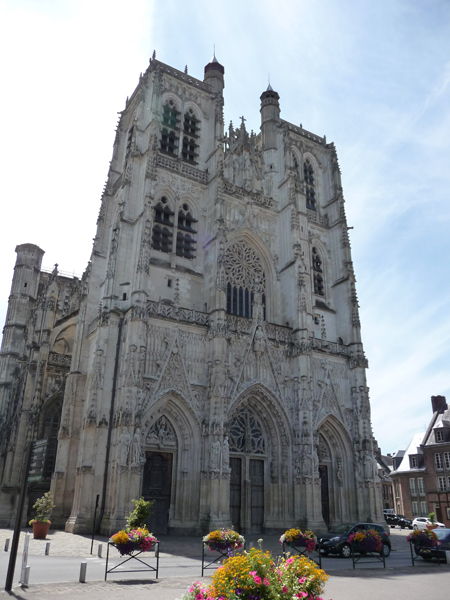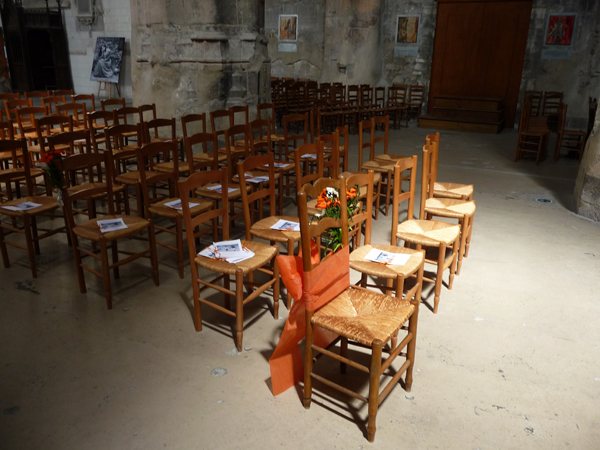This is the next in the series of blogs about my trip to France last year, following in William Morris’s footsteps.
Morris started in Abbeville, and so our tour of churches started there, too. It was July when they set out – and for us too. If it was as hot for them as it was for us I pity them in their hot Victorian clothes … and Morris in his new boots! But the Abbeville they saw was not the one that we, in 2015, visited. The church was there, rising up over the rooftops of the town just as it does in this drawing by John Ruskin from 1868. And there was a fountain in the square. But nothing else was the same.
This is what Morris says about their arrival, ‘the town itself is very and full of exceedingly good houses; we were all three in ecstasies thereat’[i]. I wish I could have said the same. Morris was in ecstasies many times in his trip, and blessedly, most of things he exclaimed about still exist, but a 160 years can bring many, many changes.
 That 160 years brought two wars to European soil. Abbeville is on the River Somme… The town was hit twice, both in the First and Second World Wars. Poor St Wulfran’s suffered a hit in the Second World War. Accordingly to my ancient French Rough Guide (1997! So long ago!) it was then ‘under scaffolding since the war’ and ‘still closed to the public’[ii], but by the time we arrived in 2015 they had reopened the church. Ish. French churches, we were to discover, are not as open as their English counterparts, even in large towns. But we got in after the desperate expedient of having a pleasant coffee and read in the same square that we see in Ruskin’s image.This is what the Place des Jacobins looks like now. Actually, it is very pleasant. But… Not quite the same.
That 160 years brought two wars to European soil. Abbeville is on the River Somme… The town was hit twice, both in the First and Second World Wars. Poor St Wulfran’s suffered a hit in the Second World War. Accordingly to my ancient French Rough Guide (1997! So long ago!) it was then ‘under scaffolding since the war’ and ‘still closed to the public’[ii], but by the time we arrived in 2015 they had reopened the church. Ish. French churches, we were to discover, are not as open as their English counterparts, even in large towns. But we got in after the desperate expedient of having a pleasant coffee and read in the same square that we see in Ruskin’s image.This is what the Place des Jacobins looks like now. Actually, it is very pleasant. But… Not quite the same.
But I understand that St Wulfran’s is all about war. I’ve read somewhere that current building was built to celebrate the return of Abbeville into French hands in 1477. Can’t find the reference now, naturally, so it may not be true! But – Abbeville has long been on the border of a battlefield – throughout the Hundred Years War it passed back and forth between the English and the French. Crécy is just up the road. This war haunted our trip in the commemoration we saw of Joan of Arc … who we, the English, killed. In those days, we wanted to be part of Europe! In the sense of owning as much of it as possible, of course, but still, we understood ourselves to be inextricably part of Europe, and had done long before the Normans arrived…
 St Wulfran’s as we see it now dates from a building campaign that began in 1488 and ended in 1539. The building dragged on past the end of the Gothic, and there was a hiatus, with the chancel being an unassuming 17th century take on Gothic, quiet and low compared to the soaring flamboyance of the architecture of the rest. Outside, the difference between the two parts is striking (though not as striking as Beauvais!) – this photograph taken from the chancel looking up at would I assume would have formed the crossing.
St Wulfran’s as we see it now dates from a building campaign that began in 1488 and ended in 1539. The building dragged on past the end of the Gothic, and there was a hiatus, with the chancel being an unassuming 17th century take on Gothic, quiet and low compared to the soaring flamboyance of the architecture of the rest. Outside, the difference between the two parts is striking (though not as striking as Beauvais!) – this photograph taken from the chancel looking up at would I assume would have formed the crossing.
 Its glory is the west front, of course. Compared to some we would see, it is restrained, but has an elegance, a simplicity in the way the plain spaces intermix with the coiling whirls of the rose window and the sculpture.
Its glory is the west front, of course. Compared to some we would see, it is restrained, but has an elegance, a simplicity in the way the plain spaces intermix with the coiling whirls of the rose window and the sculpture.
 I love this sculpture of St Eustace crossing the river in the tympanum over this door on the north side.
I love this sculpture of St Eustace crossing the river in the tympanum over this door on the north side.

And there is humour too, hidden in the arches around the doors!
The interior was cool and pleasing – and we discovered that the day before there had been an example of the entente cordiale with a wedding between a French woman and an Englishman – the ribbons were still on the chairs, orders of service still on the seats…

But what really struck me was this:

It’s a baroque intrusion into the Gothic of the church, and ordinarily I would pass it by as the baroque isn’t my favourite style, shall we say. I’m certain Morris, Burne Jones and Fulford barely noticed it. But this one is different. Unlike the rest if the interior, here the damage from the war has been left intact. I think it’s the Assumption of the Virgin – but I’m not sure as the figures are broken and stained in amid the swirling baroque clouds. It serves as a reminder that war came here and broke the world apart for the people who lived here. It reminds us that war is never far away, beneath the crumbling façade of tolerance and liberalism we built in the 20th century. Since our trip France has suffered at the hands of extremists of various sorts, Britain has cut itself off from the continent, the Far Right has risen higher than any of us who had that direct connection with WW2 in our parents and grandparents could have imagined could happen … war wages on and on in the Middle East – and over years and years of interference, part of the blame rests on western shoulders, and yet we continue to turn our backs… We need to see this sculpture with its charred clouds and dismembered women and see what war does to people … and not forget.
But what would Morris have said? I am sure he would have been horrified at the way war developed in the 20th century, and horrified too by the wanton destruction of heritage that has been brought by the use of aerial bombing and bombing on the ground. When he talks of violent revolution across the globe in his socialist writings he perhaps didn’t think through the suffering of the individuals involved nor the destruction to the physical world that would certainly have occurred. His first introduction to politics was an anti-war statement and a reaction against violence – in the Eastern Question, and the treatment of the Bulgarians by the Ottoman Empire in the 1870s. But he was also a member of the Artists Rifles in its earliest days in the 1860s (though he had a tendency to turn left when instructed to go right, with copious apologies), and his poems and novels are full of heroic violence. He was brave when confronted with violence – such as at the Bloody Sunday ‘riots’ of 1887 – and could be led by his famous temper, famously getting into trouble for allegedly bopping a policeman at an earlier protest. But he lived his life through a time when England wasn’t threatened directly either by war or by the kind of large scale terrorism we are getting used to now in the early 20th century. If he had lived through a war, either a medieval one, or one of the 20th century world wars, would his opinions have been different? Would he have recognised war for the horror it is? His vision of utopia is non-martial in the extreme, after the revolution – I’d like to believe that’s what he really wanted.
Notes:
[i] Purkiss, J ‘Morris, Burne-Jones and French Gothic’ (1991), p. 8
[ii] Baillie, K and Salmon, T France: The Rough Guide (London, 1997), p. 197
Image credits:
- Image from mapio.net
- All the rest of the images are © Kirsty Hartsiotis, 2015

 Last year my husband, Anthony, and I went on holiday to France. Our aim – or at least mine – was to follow in the footsteps of William Morris and his friends Edward Burne Jones (EBJ) and William Fulford and their dash around the great gothic churches of Northern France in 1855. They were there for three weeks, we for two. They saw more than 14 churches from Abbeville to Avranches, and we saw 8 of their 14+ from Abbeville to Louviers, falling down before Rouen and scuttling to the coast for beachside R&R on our last few days. Over that time I took notes in each church, and Anthony wrote poems. Woven in among the blogs on this site will be a series that chart that journey and Morris’s parallel one 160 years before.
Last year my husband, Anthony, and I went on holiday to France. Our aim – or at least mine – was to follow in the footsteps of William Morris and his friends Edward Burne Jones (EBJ) and William Fulford and their dash around the great gothic churches of Northern France in 1855. They were there for three weeks, we for two. They saw more than 14 churches from Abbeville to Avranches, and we saw 8 of their 14+ from Abbeville to Louviers, falling down before Rouen and scuttling to the coast for beachside R&R on our last few days. Over that time I took notes in each church, and Anthony wrote poems. Woven in among the blogs on this site will be a series that chart that journey and Morris’s parallel one 160 years before.